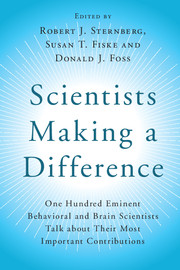 Scientists Making a Difference
Scientists Making a Difference Book contents
- Frontmatter
- Contents
- List of Contributors
- Foreword: Making a Creative Difference = Person × Environment
- Preface
- Part I Introduction
- Part II Biological Bases of Psychology: Genes, Brain, and Beyond
- Part III Cognition: Getting Information from the World and Dealing with It
- Part IV Development: How We Change Over Time
- Part V Motivation and Emotion: How We Feel and What We Do
- Part VI Social and Personality Processes: Who We Are and How We Interact
- Section A Social Cognition
- 74 Doing Good by Doing Good Research
- 75 The Incredible Little Shrinking Man in the Head
- 76 Ethnocentrism and the Optimal Distinctiveness Theory of Social Identity
- 77 Psychology of Gender: Nature and Nurture Working Together
- 78 How Warmth and Competence Inform Your Social Life
- 79 Two Routes to Persuasion
- Section B Personal Relationships
- Section C Group and Cultural Processes
- Part VII Clinical and Health Psychology: Making Lives Better
- Part VIII Conclusion
- Afterword: Doing Psychology 24×7 and Why It Matters
- Index
- References
78 - How Warmth and Competence Inform Your Social Life
from Section A - Social Cognition
Published online by Cambridge University Press: 05 August 2016
- Frontmatter
- Contents
- List of Contributors
- Foreword: Making a Creative Difference = Person × Environment
- Preface
- Part I Introduction
- Part II Biological Bases of Psychology: Genes, Brain, and Beyond
- Part III Cognition: Getting Information from the World and Dealing with It
- Part IV Development: How We Change Over Time
- Part V Motivation and Emotion: How We Feel and What We Do
- Part VI Social and Personality Processes: Who We Are and How We Interact
- Section A Social Cognition
- 74 Doing Good by Doing Good Research
- 75 The Incredible Little Shrinking Man in the Head
- 76 Ethnocentrism and the Optimal Distinctiveness Theory of Social Identity
- 77 Psychology of Gender: Nature and Nurture Working Together
- 78 How Warmth and Competence Inform Your Social Life
- 79 Two Routes to Persuasion
- Section B Personal Relationships
- Section C Group and Cultural Processes
- Part VII Clinical and Health Psychology: Making Lives Better
- Part VIII Conclusion
- Afterword: Doing Psychology 24×7 and Why It Matters
- Index
- References
Summary
Successful scientific contributions are equal parts serendipity, synthesis, integrity, and passion. My most-cited papers all have reflected ideas that happened to be in the right place at the right time – they pulled together competing perspectives, strived for scientific integrity, and were fueled by moral outrage. Of my most-cited work, our model for the two fundamental dimensions of social cognition – warmth and competence – best illustrates these principles.
When we are making sense of other people, we need to know immediately what the other individual or group intends toward us. Are they friend or foe? If they are on our side, then they seem trustworthy, sincere, friendly – in short, warm. If they are against us, they seem none of these. After inferring their intent, we need to know how capable they are of acting on it. If they have high status, we infer they are capable, skilled, effective – in short, competent.
This simple two-dimensional space has synthesis and predictive validity going for it. The combinations of warmth × competence describe common stereotypic responses to all kinds of people, whether at work or in societal groups around the world. For example, in most countries, their own citizens and their middle class generally are viewed as both warm and competent; people are proud of them. Homeless people and undocumented immigrants are stereotypically viewed as neither, and people report being disgusted by them. The mixed combinations are unique to this model: Older or disabled people are stereotyped as warm but incompetent, and people pity them. Rich or business people stereotypically come across as competent but cold; people envy them. Each combination elicits not only its distinctive emotional prejudices, but also a distinct behavioral response by the rest of society. So the model describes distinct stereotypes that predict both emotional prejudices and discriminatory tendencies.
The stereotype content model has proved useful in dozens of countries around the world, allowing us to compare across cultures. For example, any group without an address – migrants, refugees, Roma (gypsies), Bedouins (desert nomads), hobos – is viewed with distrust and contempt across the globe. Likewise, rich people are envied, yet resented as competent but cold everywhere, regardless of whether being rich is simply associated with social class or with an outsider entrepreneurial group (e.g., Jewish or Chinese people in various times and places).
- Type
- Chapter
- Information
- Scientists Making a DifferenceOne Hundred Eminent Behavioral and Brain Scientists Talk about Their Most Important Contributions, pp. 369 - 372Publisher: Cambridge University PressPrint publication year: 2016
